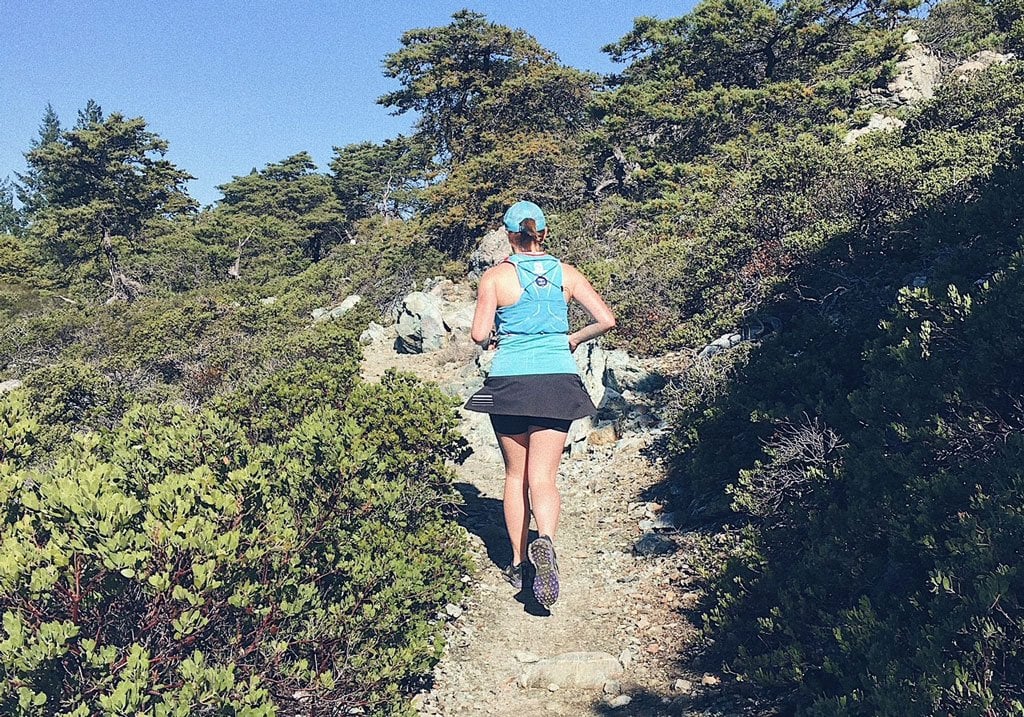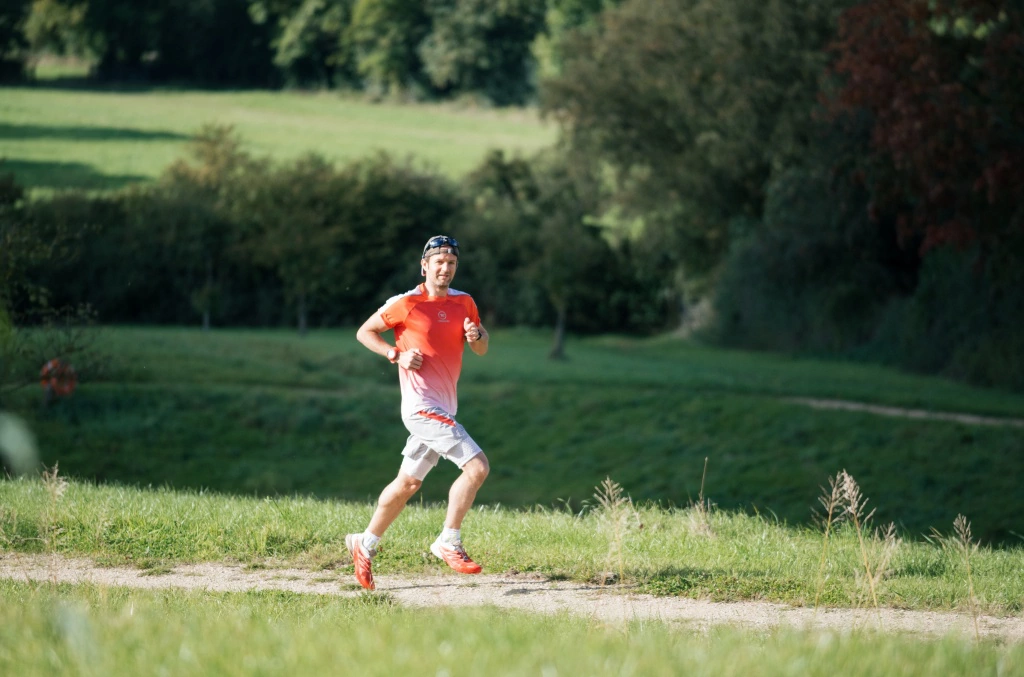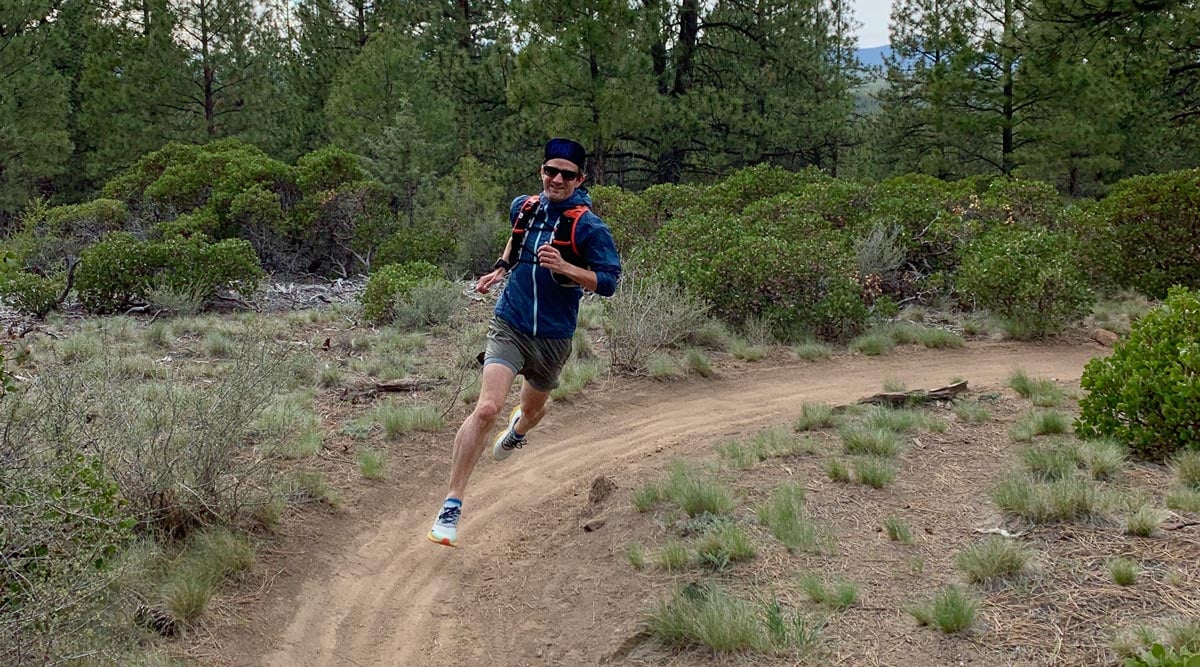If you watch a running race, whether it’s a road marathon, half marathon or a trail ultramarathon, you quickly notice that although there are many runners, they are not running in the same way.
Some people’s running technique is clearly, even to an inexperienced eye, much more efficient and apparently effortless than others – they have proper running form.
Having proper running form (aka proper running technique) like these runners is key to running faster, more efficiently over long distances and duration, and reducing your potential for running injuries.
The types of injuries that can be caused, or exacerbated by not having proper running form, include ITB pain, low back pain, shin splints and my all-time favorite, blisters on the bottom of my feet from a poor running gait.
In this post, I explain 5 key ways to teach yourself how to run with proper running form, all of which have helped me improve my own running form to become a stronger, faster, and less-injury-prone runner, and I hope will help you, too.
How To Run Better: 5 Steps To Proper Running Form
Here are some important things you can do to prevent running injuries which can be the result of having bad running form:
- Glute engagement
- Develop good posture
- Reduce stride length and change where your foot lands
- Move your arms and legs in the right planes of motion
- Improve your stride efficiency
At the end of this post I’ve also shared some other things you can change in your running and broader lifestyle that we have found also contribute to reduced running injuries, which you may find helpful.
1. Glute Engagement – It’s all about the butt. Seriously.
It seems that from consulting experts when I’ve had running overuse injuries in the past, all the overuse injuries were either caused, or exacerbated by weak and/or tight glutes.
This is apparently one of, if not the most common factor in these types of running injuries.
Getting good glute engagement is essential if you want to run with proper running technique.
Having weakness and/or tightness in such large, important muscles, means other parts of your body (especially your legs and back) have to work harder and not always in the right way, to compensate, and you definitely aren’t moving with proper running form if that is the case.

It makes sense if you think about it.
Hours a day sitting on your butt, whether at a desk or driving, does nothing to engage or strengthen your glute muscles – so this is a common cause of poor running form for many people.
Have you heard of ‘glute activation’?
This means exercises designed to target and engage those unloved and underused butt muscles.
If your neural pathways (how your brain sends signals to your body) are simply bypassing even bothering to use those muscles when you stand, walk or run, then you’re not using your body in the most efficient way, you’re probably not running with proper running form.
This means you could be missing out on performance and strength gains, as well as reducing your propensity for running injuries.
How to ‘activate’ and strengthen your glutes for running (or hiking)
I like to build my favorite glute strength exercises into broader running strength and conditioning cross-training, which I do regularly to help improve my running form and hopefully also reduce my propensity for getting running injuries.
This includes yoga and cross-training workouts requiring little to no equipment.
This playlist on our YouTube channel features some examples.
We’re constantly adding more running workout videos so if you like what you see, don’t forget to subscribe while you’re on our channel!
I also wrote more about the exercises I started doing regularly in my popular post on ‘running blisters caused by gait‘, and this post lists out our favorite home workout equipment.
Aside from exercises you can do when NOT running, the crucial thing that has really helped me is to THINK about using my butt to run.
Sound silly? Yes! Works? Yes!
How do I engage my glutes while running?
Well, I literally think about engaging and using my butt muscles to push-off the ground with every step.
If you like to recite mantras, why not try this and tell yourself ‘left-cheek-right-cheek-left-cheek-right-cheek…etc etc’.
I promise this really helps you teach yourself to run in a different way to just running however you did before – whether you were overusing your low back, shoulder muscles, hamstrings or calves.
It will help you learn to have your foot strike the ground at the right part of the cycle. You’ll probably heel strike less, as a result (heel striking is often a cause of many annoying running injuries, such as shin splints).
Remember, every accomplishment starts with the decision to try!
left-cheek-right-cheek-left-cheek-right-cheek
It’s better to say this in your head, rather than out loud…
Once you get used to doing this, you should have developed some muscle memory and hopefully improved strength as those muscles get used to being used. Aaaaand hopefully less overuse in the other muscles.
It can be hard maintaining proper running form when you’re tired, such as during long training runs if you don’t practice these secrets to running longer.
I find that this mantra really helps me when I’m tired and have been running for 2+ hours, or if I’m really pushing for a segment or speed at the end of a run, because not only does it help me use the right muscles, but it makes me noticeably FASTER.
2. Improve running posture
To run with correct running form it’s important to ENGAGE YOU CORE.
I find it amusing to think about my body as a sack (the glamor!) and I don’t want to be a saggy sack moving along the trail.
I want to be running tall and strong and elongate my core. You don’t want a stiff upper body – keep it relaxed, so it helps to focus on engaging your core and having a straight back, rather than tensing everything up.
Thinking about what my upper body is doing, and keeping it straight and tall when I run really helps with my overall posture – my eyes are naturally looking more forward ahead of me (rather than towards the ground), my upper body is more upright (stacked in a straight line, with a slight forward lean).
Engaging your core means that the muscles around the center of your body – not just your abs but around your sides and back – are doing their job to stabilize you while your legs move and arms swing, reducing unnecessary movement up and down and from side to side as you run.
You’ll probably find straight away that this posture improvement helps you breathe more easily as you run. Equally, breathing properly when you run will also help you improve your posture. To learn more about how to do this, read how to breathe while running.
Putting your effort into having good running posture makes you a more efficient runner, and you’re probably closer to having proper running form this way.
You should find that the immediate result is that you start to run that bit faster just from this one change in running posture and muscle engagement.
If you feel your back could do with being massaged and reducing tension, then the Chirp Wheel is another great gadget to have at home to help relax your back.
In order to build strength, the muscles shouldn’t be overly tight or in spasm, so having a way to relax your back at home (which is way better than using a foam roller) is useful.
3. Think about your running footfall and stride length
Having an efficient cadence and modest stride length rather than over-striding was a key way I reduced my propensity to suffer from shin splints and other running injuries (resulting from the strain of running downhill, in particular).
It also really helps to think about HOW your feet land on the ground, as this will help determine whether you should try shortening (or for some people, perhaps lengthening) your stride length, at least on certain terrains.
It’s well-documented that for most people, as was the case with me, landing gently with your midfoot is much better for your body than heel-striking or landing on the balls of your feet, so this is what I concentrate on doing.
By making changes in your stride length, you’ll probably find that your running cadence changes.
Generally, a running cadence of 180 steps per minute is considered to be a good cadence for efficient running – it may seem like a lot when you first make these changes, but you will get used to it pretty quickly after a few runs!

Also – wearing the right running shoes can really help make a difference to how your run in terms of stride length and where your foot lands, which can in turn help you run with correct running form.
Generally, a more minimal shoe with a lower drop from heel-to-toe will encourage a more efficient, natural running style than a chunkier, more cushioned shoe.
However, a more minimal running shoe will generally offer less foot protection and, depending on how and where you run, may not be enough.
Personally I like something in the middle, with a drop of 4mm-8mm and some cushioning in the sole, especially for runs of more than an hour where my tired feet may appreciate the extra padding in a more forgiving running shoe.
If you are curious to know more about what to look for in a trail running shoe, the different types of trail running shoes and our list of the best available right now, head over to our ultimate guide to trail running shoes.
4. Don’t twist your upper body – get in the right planes of motion
When I am running I think about how my arms and legs move in terms of ‘planes of motion’.
What I mean by that is that I don’t want to be twisting my hips, knees, upper body or shoulders and have much (if any) rotation across my body.
Those limbs need to move like a steam train! That’s what I visualize when I’m working towards moving with good running form.
Arms swing front to back, and legs swing forward and back from the hips, in the same plane of motion. Don’t let either leg or arm swing across your body, or twist as it moves forwards or back.
If you prefer to visualize something more exciting than a steam train, then how about the cartoon ‘Road Runner’?
While he doesn’t have arms, his legs move efficiently in one plane of motion and he also has great hip extension.
5. Push-off, knee drive and paw-back
Now, I’m not saying my running form is excellent by any means, but these are all things I think about and am working on – and have definitely helped to improve my running technique, speed, endurance and injury prevention.
These three all relate to how you are moving your legs with each stride, to drive you forward.
If you break a stride down, your legs go through three phases, push-off, knee drive and paw-back.
This is the difference between a jogger’s ‘shuffle’ and looking like an elite Olympic athlete.
If you watch footage of an elite runner run on a track, especially in slow-motion, you can see how far they swing forward their knees, how far back their leg is pushed out back behind them, and how long each foot lands and stays on the ground, ‘pawing back’ to drive forward motion.
You’ll also see what their foot strike looks like. The most efficient runners tend to land with a mid or forefoot foot strike – never a heel strike. It’s hard to have an efficient paw-back if you’ve landed heel-first, because your foot is out in front of you rather than in a position to push back behind you.
Then have someone film you running, from the side-on, and see how different your running form is.
This gives you an idea of how important strength and flexibility is through your ankles, knees, glutes and hips especially, so that they may enable you to be able to train and run with an increased range of motion to get closer to having proper running form.

Obviously it’s not practical to run like that everywhere, and the range of motion generally decreases as you increase in distance and running duration, but it’s still important even if you’re not running at full-speed or trying to race anyone.
The advice I have been given for improving my paw-back is to imagine you’re wiping dog poop off your shoe, which is an easy concept to remember.
It’s that intentional ground contact and push-back that you’re aiming for, except while hopefully you don’t have something stinky on your shoe, you’re simply just trying to maximize the opportunity to use the ground to propel you forward.
Other ways to help stay injury free
There’s a reason that just from the act of running and focusing on nothing but the act of running and your running technique (including all of the things I’ve listed above to achieve proper running form), your mind becomes so full of being in the moment that it is a form of moving meditation.
The pursuit of achieving proper running form is, to me, the same as the pursuit of mindfulness through running.
When you’re focusing hard on maintaining good running technique, it’s hard to think of anything else, which is, of course, much of the attraction.
Better running performance and reducing overuse injuries is not just about having proper running form.
Recovery, strength training, eating and sleeping well have all contributed to improvements in my running performance, strength and reducing my propensity to suffer from running injuries due to poor form, training, nutrition or recovery (or all of the above).
If your training plan calls for doing an easy recovery run a day or two after a tough workout, make sure those recovery runs are done correctly to avoid over-training.
Consider aids for your recovery, such as some recovery shoes like Kane Footwear, or some inexpensive toe spacers to help your feet get back into a more natural alignment after a lot of time wearing shoes.
Here are some other specific posts you may find interesting:
- The best stretches for runners to do before and after running
- How to become a stronger, faster runner
- The T&K guide to heart rate training for runners
- How to run up hills faster and more efficiently
- 10 easy yoga stretches for runners
- CBD for runners and athletes
Having switched to a plant-based diet, the level of training-related inflammation and soreness I experience is definitely less than it used to be, so eating more plants is also something else I strongly recommend you explore if you’re looking for ways to reduce running injuries and improve your running form.






